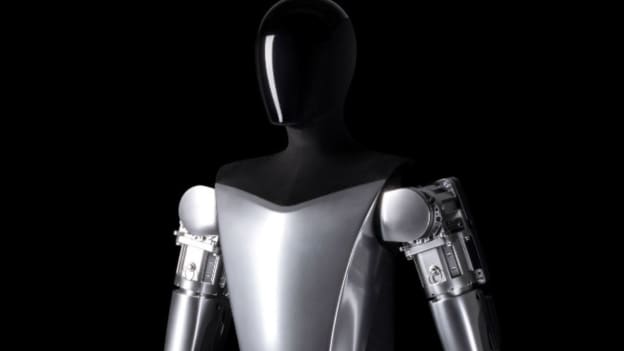The rise of Elon Musk's AI robot workforce

Tesla envisions making humanoid robots in very high volumes, possibly even in the millions.
Tesla is doubling down on its commitment to advancing the field of robotics powered by artificial intelligence with the unveiling of its ‘Optimus’ humanoid robot.
Tesla CEO Elon Musk appeared on stage to introduce Optimus. The robot greeted the people with a wave. The audience was then treated to a short video of the prototype AI robot carrying a box, watering plants, and moving metal bars at one of Tesla’s factories.
The unveiling of Optimus is part of Tesla’s venture into the robotics business, which Musk believes will be worth more to the electric vehicle maker than its automobiles. The company is looking to expand its business opportunities beyond developing self-driving cars.
“Our goal is to make a useful humanoid robot as quickly as possible,” Musk said. “There’s still a lot of work to be done to refine Optimus and prove it.”
Read more: This robot is designed to mimic human workers
Tesla’s ‘extremely capable robot’
During the presentation, Musk discussed the challenges of developing humanoid robots. For one, their ability to navigate the world on their own is still very limited since most machines are currently “missing a brain”. Robots are also very expensive to produce and can only be made in low volumes.
Unlike earlier robots, however, Optimus promises to be an “extremely capable robot”. Tesla envisions making humanoid robots in very high volumes, possibly even in the millions. The company expects one unit to cost only under US$20,000, making it much more affordable compared to a car.
Read more: Ready to meet your AI boss? Firm hires robot CEO
Optimus carries a 2.3 kWh 52V battery pack, giving the unit enough power for “about a full day of work” on a single charge, according to Tesla engineers.
The robot’s ‘muscles’ are made up of 28 custom structural actuators, six of which are found in its hands alone. These cable-driven actuators provide Optimus with 11 degrees of movement and allow it to grasp and use small tools using its metal phalanges.
Read more: Is your job at risk of an Ai takeover?
Will the Optimus robot replace human workers?
As for Optimus’ practical applications, Tesla sees the humanoid robot working at assembly lines in factories. It can take part in manufacturing products similar to how human workers do. And, with a projected low unit cost, the robots can be produced at scale.
Despite the potential to supplement human labour, however, Optimus robots will not be making their way to workplaces anytime soon.
Tesla estimates that the AI-powered humanoid robots will not be available for purchase for at least another three to five years.















